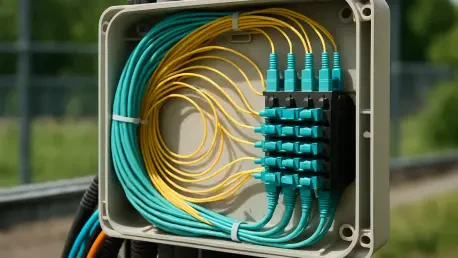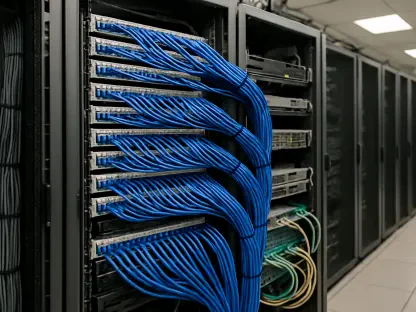The digital revolution, spearheaded by hyperscale cloud giants such as Amazon, Google, and Microsoft, is transforming the landscape of data infrastructure across the United States in ways that could have far-reaching implications for rural communities. As these tech behemoths expand their data center footprints to meet soaring demand for cloud services, they are increasingly drawn to rural and remote areas where power is abundant and affordable, often bypassing traditional urban hubs. This migration poses a compelling question: could this surge in data center development catalyze the much-needed expansion of fiber optic networks in underserved rural regions? With millions of Americans still lacking reliable high-speed internet, the convergence of data center growth and fiber deployment presents a potential opportunity to address the persistent digital divide. Exploring this dynamic reveals a complex interplay of economic, logistical, and strategic factors that could shape the future of connectivity in areas long left behind by technological progress.
The Push for Power in Remote Regions
The insatiable energy demands of data centers are a key driver behind their relocation to rural landscapes, where access to cheap, reliable electricity often trumps the challenges of limited infrastructure. These facilities consume vast amounts of power to keep servers running and cooled, making energy costs a critical factor in site selection. Rural areas, with their lower land prices and proximity to renewable energy sources or underutilized power grids, are becoming attractive destinations. However, this shift places immense pressure on fiber optic providers to extend networks into regions that lack existing connectivity. While the demand from hyperscalers is evident, building infrastructure in sparsely populated areas often requires significant investment with uncertain returns. Industry discussions highlight that without a clear path to profitability or substantial backing, many providers remain hesitant to commit to such ambitious projects, even as the need for digital expansion grows.
Beyond the immediate challenge of power access, the rural push by data centers underscores a broader tension between opportunity and feasibility in extending fiber networks. Hyperscalers often act as anchor customers, providing the initial justification for costly builds, but their involvement doesn’t always guarantee long-term financial stability for providers. Rural locations may offer power advantages, but they lack the population density to support diverse revenue streams that could offset infrastructure costs. This creates a dilemma for fiber companies, who must weigh the potential of tapping into new markets against the risk of overextending resources. As data centers continue to prioritize energy over proximity to urban centers, the ripple effect on fiber deployment strategies becomes increasingly pronounced, forcing stakeholders to rethink traditional approaches to network expansion in less populated regions of the country.
Financial Hurdles in Connecting the Countryside
Extending fiber optic networks to rural areas is not merely a technical endeavor but a significant financial gamble that often deters investment. Historically, many of these regions have remained unconnected because the cost of deployment far outweighs the potential revenue from a limited user base. Fiber providers frequently seek an anchor customer—typically a hyperscaler—to support the economics of such projects, but recent trends suggest that subsidies from these large clients are shrinking. This shift places greater financial strain on providers, who must either absorb higher costs or find alternative ways to make builds viable. Industry leaders emphasize a cautious approach, warning against the temptation to overcommit to projects in unproven markets where long-term demand remains uncertain, even as the allure of data center-driven growth persists.
The economic challenges of rural fiber builds are compounded by the need for innovative funding models or partnerships to bridge the investment gap. Government initiatives aimed at improving broadband access offer some hope, yet they often fall short of covering the full scope of expenses in remote areas. Without a diversified customer base to sustain operations, providers face the risk of thin margins or outright losses on infrastructure that may take years to become profitable. This financial tightrope is a recurring concern among experts, who note that while data center projects can spark initial interest, sustaining momentum requires more than just a single large client. Balancing fiscal responsibility with the potential to connect underserved communities remains a critical hurdle, as the industry grapples with how to turn rural fiber deployment into a sustainable reality rather than a costly experiment.
Urban vs. Rural Connectivity Pressures
While rural areas face unique challenges tied to data center expansion and power availability, urban centers are experiencing a different but equally pressing demand for fiber upgrades. Metropolitan regions, characterized by high data traffic and dense concentrations of users, are witnessing significant investments to meet the needs of hyperscale operations. The urgency in these areas is evident through innovations like pre-deployed optical circuits, which can be activated almost instantly to address sudden spikes in demand. This rapid response capability underscores the critical role of fiber in supporting the data-heavy ecosystems of cities, where proximity to end users and existing infrastructure often outweighs the lure of cheaper power found in rural locales. The focus on metro connectivity highlights a stark contrast in priorities for data center and fiber strategies across different geographies.
In contrast to rural builds driven by power-seeking data centers, urban fiber expansion is fueled by the sheer volume of data and network activity concentrated in city environments. Companies are pouring billions into both metro and long-haul fiber to keep pace with hyperscaler requirements, ensuring that latency and bandwidth constraints do not hinder operations. This dynamic reveals a bifurcated approach within the industry, where some data center operators prioritize staying close to data gravity and user bases over chasing remote energy sources. For fiber providers, navigating these dual demands means allocating resources effectively between high-density urban upgrades and speculative rural projects. The divergence in focus illustrates the complexity of scaling connectivity nationwide, as each region presents distinct obstacles and opportunities that shape how infrastructure investments are prioritized and executed.
Aligning Data Centers with Broadband Goals
One of the most promising aspects of data center expansion into rural areas is the potential synergy with government efforts to close the digital divide, such as the Broadband Equity, Access, and Deployment (BEAD) program. Although these initiatives have yet to produce widespread connectivity improvements, the infrastructure laid down for hyperscale data centers could serve as a foundation for broader rural broadband access. If fiber providers can leverage these initial builds to connect surrounding communities, what starts as a necessity for a single large client could evolve into a public good. However, this outcome depends heavily on the ability to monetize networks beyond the anchor customer, ensuring that the economics of rural deployment align with societal benefits rather than remaining a niche corporate solution.
Achieving this alignment requires strategic collaboration between private industry and public policy to maximize the impact of data center-driven fiber projects. The challenge lies in transforming infrastructure originally designed for hyperscalers into a resource that supports local residents and businesses in underserved areas. Without additional revenue streams or incentives, providers may struggle to justify expanding service beyond the primary client, limiting the broader impact on rural connectivity. Discussions among stakeholders suggest that while the potential exists, realizing it demands creative approaches to funding and network planning. As data center growth continues to push into remote regions, the opportunity to support national broadband goals becomes a tantalizing prospect, provided the industry can navigate the financial and logistical barriers that have historically kept rural America offline.
Hyperscalers as Catalysts for Fiber Innovation
Hyperscale cloud providers stand as dominant forces reshaping the fiber optic industry, driving demand for expansive, high-capacity networks that challenge traditional business models. Their influence has been a game-changer, compelling fiber companies to secure substantial investments and pivot strategies to meet the scale and speed required by these tech giants. From massive builds to accommodating high conduit counts, the push from hyperscalers is redefining how providers approach infrastructure development. This shift is not just a response to current needs but a signal of a larger trend, where the entire national fiber network—spanning metro and long-haul routes—faces the need for a comprehensive overhaul to support the burgeoning digital economy and the relentless growth of data consumption across all sectors.
The transformative role of hyperscalers also fosters a competitive landscape where innovation becomes a key differentiator for fiber providers. As these large clients demand more efficient and scalable solutions, companies are forced to rethink deployment timelines, cost structures, and technological capabilities. The consensus among industry observers is that this pressure will likely accelerate upgrades to national infrastructure, ensuring it can handle modern data center demands. Additionally, the rise of startups with leaner operations poses a challenge to established players, potentially disrupting the market with more competitive offerings, especially in rural builds. This evolving dynamic suggests that hyperscalers are not just customers but catalysts for a broader reinvention of how fiber networks are planned and implemented, setting the stage for a future where connectivity is both ubiquitous and robust.
Building Tomorrow’s Connected Rural Landscape
Reflecting on the trajectory of data center expansion, it’s evident that the industry has navigated a critical juncture where power needs intersect with connectivity challenges in rural America. The push into remote areas by hyperscale providers has sparked a wave of discussions around fiber deployment, balancing economic constraints with the promise of broader access. Urban upgrades, meanwhile, have progressed with urgency, meeting dense data demands through innovative solutions. Looking ahead, the next steps involve fostering partnerships between private entities and public programs to ensure rural fiber builds extend beyond single clients to community-wide benefits. Stakeholders need to prioritize sustainable models, leveraging data center momentum to support national broadband goals. As competition and innovation reshape the fiber landscape, the focus shifts to creating a resilient infrastructure that can bridge digital divides, ensuring that rural regions are no longer left behind in the digital age.









